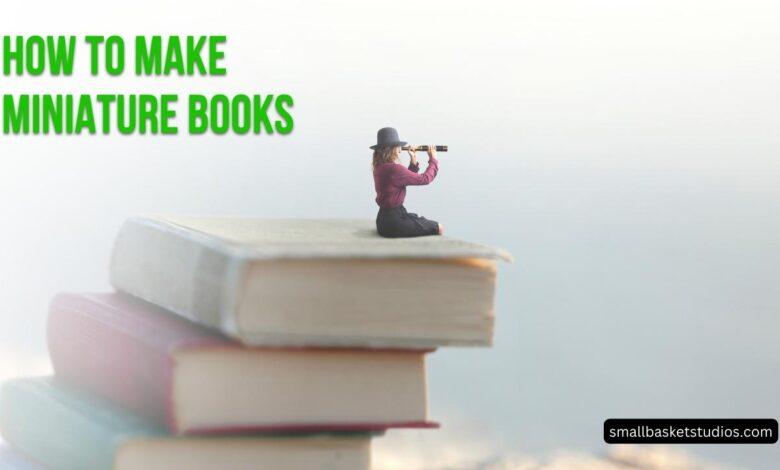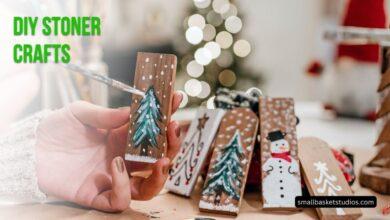How to Make Miniature Books: A Professional Guide

Miniature books have been around for centuries and are often admired for their intricate design and small size. Creating miniature books can be a fun and rewarding hobby for book lovers, craft enthusiasts, and collectors alike. Whether you want to make a tiny replica of your favorite novel or create a unique gift for a loved one, making miniature books can be a great way to showcase your creativity and attention to detail.
Understanding the basics of miniature book making is essential before diving into the process. Choosing the right materials, creating a book template, and assembling the book are all important steps that require careful consideration. Additionally, selecting the right content for the book and adding finishing touches can help make the book more visually appealing and unique. Troubleshooting common issues that may arise during the process and learning how to properly preserve and care for your miniature books can help ensure that they last for years to come.
Key Takeaways
- Understanding the basics of miniature book making is essential before starting the process.
- Choosing the right materials, creating a book template, and assembling the book are important steps to consider.
- Troubleshooting common issues and properly preserving and caring for miniature books can help ensure their longevity.
Understanding Miniature Books
Miniature books are exactly what they sound like – tiny books that are usually no more than a few inches tall or wide. They can be used for a variety of purposes, from dollhouse accessories to actual reading material. Despite their small size, miniature books can be incredibly detailed and intricate, making them a popular choice among bookmakers and collectors.
Creating miniature books requires a bit of patience and attention to detail. Bookmakers typically use a variety of materials, including paper, glue, and thread, to create the pages and binding. Some miniature books even feature illustrations and decorative covers, making them true works of art.
There are a few different types of miniature books, each with their own unique characteristics. For example, thumb bibles are miniature Bibles that were originally designed to be small enough to fit in a person’s pocket or on a keychain. Other miniature books may be designed to be used as jewelry or other accessories.
Despite their small size, miniature books can be just as complex as their full-sized counterparts. They often require the same level of precision and attention to detail, making them a challenging but rewarding project for bookmakers of all skill levels. Whether you’re interested in creating miniature books as a hobby or for a specific project, understanding the basics is an important first step.
Materials Needed
To make miniature books, there are a few materials that are necessary to have on hand. Here is a list of some of the most important materials:
Paperboard
Paperboard is a sturdy type of cardboard that is ideal for creating the covers of miniature books. It is recommended to use paperboard that is similar in thickness to a Pop Tarts or Famous Amos cookie box.
Fabric
Fabric can be used to cover the paperboard covers of miniature books. It is recommended to use fabric that is thin and lightweight, such as cotton or silk.
Cute Paper
Cute paper can be used to create the pages of miniature books. This can include patterned scrapbook paper, origami paper, or any other type of decorative paper.
Mod Podge
Mod Podge is a type of glue that is commonly used in crafting. It can be used to attach the fabric to the paperboard covers and to attach the pages to the spine of the book.
Scissors
Scissors are necessary for cutting the paperboard, fabric, and pages of the miniature book to the correct size.
Pencil
A pencil is useful for marking the paperboard and pages before cutting them.
Paintbrush
A paintbrush can be used to apply the Mod Podge to the fabric and paperboard.
Glue Stick
A glue stick can be used to attach the pages of the miniature book to each other.
Regular Glue
Regular glue can be used to attach any embellishments to the cover or pages of the book.
White or Colored Paper
White or colored paper can be used to create the pages of the miniature book if cute paper is not available.
Paper Cutter or Page Template and Ruler
A paper cutter or page template and ruler can be used to ensure that all of the pages are cut to the same size.
Eraser
An eraser is useful for removing any pencil marks from the paperboard or pages.
Needle and Thread
A needle and thread can be used to bind the pages of the miniature book together.
Binder Clip
A binder clip can be used to hold the pages together while the glue dries.
Choosing the Book Content
When it comes to making miniature books, choosing the right content is essential. The content should be interesting and engaging, but also suitable for the size of the book. Here are some tips on how to choose the right content for your miniature book.
Selecting Text
The text is the most important part of any book, and miniature books are no exception. When selecting text for your miniature book, consider the following:
- Choose a text that is short and concise. Miniature books have limited space, so you want to make sure that the text is not too long.
- Consider the font size and style of the text. The font should be legible and easy to read, even at a small size.
- Choose a text that is appropriate for the size of the book. For example, a novel may not be suitable for a miniature book, but a short story or poem could be perfect.
Choosing Images
Images can add visual interest and enhance the content of a miniature book. When choosing images for your miniature book, consider the following:
- Choose images that are high-quality and clear. Blurry or pixelated images will not look good in a miniature book.
- Consider the size of the images. Images that are too large may not fit in a miniature book, so make sure to choose images that are the right size.
- Choose images that are relevant to the content of the book. For example, if you are making a miniature book about flowers, choose images of flowers rather than animals or landscapes.
By following these tips, you can choose the right content for your miniature book and create a beautiful and engaging work of art.
Creating the Book Template
Creating a template for your miniature book is an essential step in the book-making process. It ensures that all the books you create are uniform in size and shape. Here are some steps to follow when creating your book template.
Designing the Cover
The cover of your miniature book is the first thing that people will see. Therefore, it is essential to design a cover that is visually appealing and matches the theme of your book. Here are some things to consider when designing your cover:
- Size: The cover should be slightly larger than the pages of the book to protect them. A good rule of thumb is to make the cover 1/8 inch larger than the pages.
- Color: Choose a color that complements the theme of your book. If you’re making a book about nature, for example, you might choose earthy tones like green or brown.
- Images: Use images that are relevant to the theme of your book. You can find free images online or create your own using software like Canva.
Formatting Pages
Once you have designed your cover, it’s time to format the pages of your book. Here are some things to consider when formatting your pages:
- Size: The size of your pages will depend on the size of your cover. Make sure that the pages are slightly smaller than the cover so that they fit inside.
- Margins: Leave a small margin around the edges of the pages to prevent text or images from getting cut off.
- Font: Choose a font that is easy to read and matches the theme of your book. Avoid using fonts that are too small or too fancy, as they can be difficult to read.
By following these steps, you can create a book template that can be used to make multiple miniature books. This will save you time and ensure that all your books are uniform in size and shape.
Assembling the Book
Once the pages are printed and cut to size, it’s time to assemble the miniature book. This section will cover the two main steps: binding the pages and attaching the cover.
Binding the Pages
There are several ways to bind the pages of a miniature book. One popular method is coil binding. This involves punching holes along the edge of the pages and threading a plastic or metal coil through them. To do this, follow these steps:
- Make sure your coil is at least 1″ longer than your mini book pages (so there is 1/2″ on each side to allow for cutting/crimping).
- Punch your pages with a coil binding punch or use pre-punched coil paper cut down to size.
- Roll your coil through the holes.
- Use crimping pliers to crimp the ends of the coil to keep it in place.
Another option is saddle stitching, which involves folding the pages in half and stapling them together along the fold. To do this, follow these steps:
- Fold the pages in half.
- Staple along the fold, making sure the staple goes through all the pages.
- Cut off any excess staple wire.
Attaching the Cover
Once the pages are bound, it’s time to attach the cover. This can be done in several ways, including:
- Gluing the cover directly onto the bound pages
- Creating a separate cover and attaching it to the bound pages using glue or double-sided tape
- Using a cover with flaps that can be folded over and glued onto the bound pages
No matter which method you choose, make sure the cover is properly aligned with the pages and that the glue or tape is applied evenly to avoid any wrinkles or bubbles.
With these steps, anyone can create a miniature book that is both functional and visually appealing.
Finishing Touches
Once the miniature book is complete, it’s time to add some finishing touches to make it look even more impressive. This section will cover some of the ways to add details and seal the book.
Adding Details
Adding details is an excellent way to make the miniature book stand out. One way to add details is by using stickers or stamps. You can use stickers or stamps to add designs, patterns, or images to the cover or inside pages of the book. Another way to add details is by using washi tape. Washi tape is a decorative tape that comes in various colors and patterns. You can use washi tape to create borders or frames around the pages or cover of the book.
Sealing the Book
Sealing the book is an essential step to protect it from damage and give it a finished look. One way to seal the book is by using Mod Podge. Mod Podge is a glue-like substance that dries clear and creates a protective layer over the book. You can apply Mod Podge to the cover and pages of the book using a paintbrush. Another way to seal the book is by using clear contact paper. Clear contact paper is a transparent adhesive film that you can cut to size and apply to the cover and pages of the book.
Overall, adding details and sealing the book are simple but effective ways to make the miniature book look even more impressive. With a little creativity and attention to detail, anyone can create a beautiful miniature book that is sure to impress.
Troubleshooting Common Issues
Creating miniature books can be a fun and rewarding experience, but it’s not without its challenges. Here are some common issues that may arise and how to troubleshoot them:
Pages are Falling Out
If the pages of your miniature book are falling out, it could be due to a few different reasons. One possibility is that the glue you used to bind the pages together was not strong enough. Try using a stronger adhesive or applying more glue to ensure that the pages stay in place.
Another possibility is that the paper you used for the pages is too thin or too slick, which can make it difficult for the glue to adhere properly. Consider using a slightly thicker paper or roughing up the surface of the paper slightly to help the glue stick.
Cover is Misaligned
If the cover of your miniature book is misaligned, it can be frustrating. One possible cause is that the cover was not cut or folded precisely. Make sure to measure and mark your paper carefully before cutting and folding to ensure that everything lines up properly.
Another possibility is that the glue you used to attach the cover to the pages was not applied evenly. Try applying the glue in small, even amounts and pressing the cover firmly into place to help ensure that it lines up correctly.
Pages are Wrinkled or Creased
If your miniature book pages are wrinkled or creased, it can be unsightly and make it difficult to read. One possibility is that the paper you used was too thin or flimsy, making it prone to wrinkling or creasing. Consider using a slightly thicker paper to help prevent this issue.
Another possibility is that the paper was not folded or handled carefully, leading to wrinkles or creases. Make sure to handle your paper gently and fold it carefully to help prevent this issue.
Overall, creating miniature books can be a fun and rewarding experience, but it’s important to troubleshoot any issues that arise to ensure that your finished product looks great and functions properly.
Preservation and Care of Miniature Books
Miniature books require special care and attention to ensure they remain in good condition for years to come. Here are some tips to help preserve your miniature book collection:
Handling
When handling miniature books, it is important to use clean hands and handle them gently. Avoid touching the pages directly, and use a clean, dry cloth to turn the pages. If the book has a dust jacket, remove it before handling the book to prevent damage.
Storage
Miniature books should be stored in a cool, dry place away from direct sunlight and humidity. They should be stored upright to prevent warping or bending. If possible, store them in acid-free boxes or sleeves to protect them from dust and other contaminants.
Cleaning
If your miniature books become dirty, use a soft-bristled brush to gently remove any dust or debris. Avoid using water or cleaning solutions, as these can damage the pages and bindings. If the book has a dust jacket, remove it before cleaning to prevent damage.
Repairs
If your miniature book becomes damaged, it is best to seek the help of a professional book conservator. Attempting to repair the book yourself can cause further damage and decrease the value of the book.
By following these tips, you can help ensure that your miniature book collection remains in excellent condition for years to come.
Frequently Asked Questions
What are some creative mini book design ideas?
There are many creative mini book design ideas that you can try out. Some popular ideas include using vintage book covers, creating your own custom book covers, using unique materials like wood or leather for the covers, and experimenting with different binding techniques. You can also add decorative elements like ribbons, beads, or charms to make your mini books even more unique.
How can you make miniature books using A4 paper?
To make miniature books using A4 paper, you can fold the paper in half and then cut along the fold to create two smaller sheets. Then, fold each sheet in half again to create a booklet. You can use this basic technique to create a variety of different mini book sizes and shapes.
What are some printable free miniature book cover templates?
There are many printable free miniature book cover templates available online. Some popular sources include Pinterest, Etsy, and various crafting blogs. You can also create your own custom templates using graphic design software like Canva or Photoshop.
How can you print miniature books?
To print miniature books, you will need to adjust your printer settings to ensure that the pages are printed at the correct size. You can do this by selecting the “scale to fit” option in your print settings and adjusting the percentage until the pages are the desired size. You can also print multiple pages per sheet to create smaller booklets.
What are some popular ways to bind mini books?
Some popular ways to bind mini books include saddle stitching, perfect binding, and Japanese stab binding. Saddle stitching involves stapling the pages together along the spine, while perfect binding involves gluing the pages to the spine. Japanese stab binding involves sewing the pages together using a decorative thread.
How are miniature books typically printed?
Miniature books are typically printed using a variety of printing techniques, including offset printing, digital printing, and letterpress printing. The choice of printing technique will depend on factors like the desired print quality, the number of copies needed, and the budget available.




